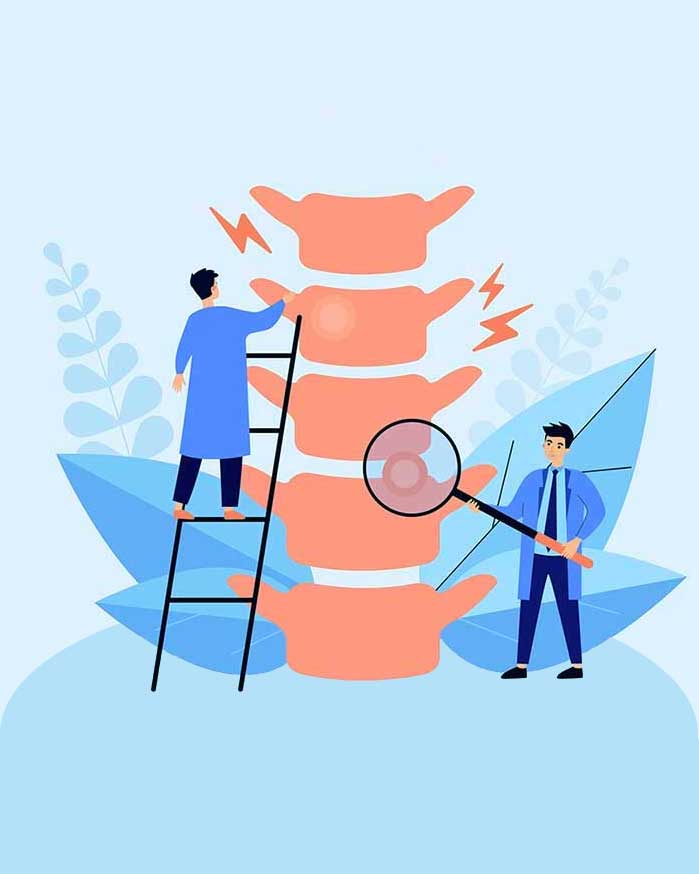Sciatica
If you develop a pain that starts in your lower back or buttock and radiates down your leg, your problem may be sciatica.

What is sciatica?
Sciatica is an irritation of the sciatic nerve, which is the largest nerve in the human body. Sciatic nerves originate from several nerves in your lower back. These nerves branch outward from the spine and then come together at each buttock to form the sciatic nerve, which then radiates down each leg. Sciatic nerve pain radiates along the same path.
Sciatica can affect people of almost any age except the very young. The symptoms may get worse with age but they may also get better with age. How one manages their symptoms will play a significant role. One should be able to maintain an active lifestyle such as playing sports when having symptoms of sciatica but the decision regarding restriction of activities should not be made as generalized rule and should always be individualized. Pain is always a good guide but should not be the only guide. Weakness and numbness are two neurological symptoms that should be considered and taken very seriously.
What are the symptoms of sciatica?
The typical first symptom is pain that radiates from the lower back or buttock region down one leg. The pain feels as if it is coming from the sciatic nerve in the buttocks region because of its location, but the pain almost always originates from an irritated nerve in the lower spine.
Generally, symptoms include:
- Dull, aching, shooting or "burning" pain that starts in your lower back and/or buttock and radiates down one of your legs. Back pain accompanied by leg pain is the key symptom that suggests you have sciatica rather than another type of back pain.
- Neuropathies such as numbness or a “pins and needles” tingling sensation.
- Feelings of muscle weakness or altered reflexes.
Depending on the location of the compressed nerve, your symptoms may worsen when you bend over, lift objects, twist, sit down, cough or sneeze.
What causes sciatica?
Irritation of the sciatic nerve is caused by nerve root entrapment (also known as nerve compression, pinched nerve or entrapment neuropathy). This particular form of entrapment is called lumbar radiculopathy, since the damaged nerves roots are located in the lumbar (lower back) portion of the spine. The nerve compression itself is most commonly irritated from disc tissue that is compressing the nerve, other structures in the spine that can also compress the nerve, or by an inflammatory reaction near the nerve.
Causes of sciatica include:
- A herniated disc – also known as a ruptured or slipped disc – in which the gel-like center of an intervertebral disc of the spine sticks out through a tear in its outer ring (called the annulus). This slippage puts pressure on the nerve roots located just next to the disc. Herniated discs can be brought on by wear-and-tear over time or by an acute back injury.
- Spinal stenosis – a narrowing of the canal that houses the spinal nerves.
- (Less often) inflammation of body parts adjacent to the spine, which in turn may be caused by:
- bone or muscle injuries such as a broken hip
- diseases such as tumors or infections
- pregnancy
- orthopedic surgery of the hip
There are many contributing factors that may increase the risk of sciatica, but one of the most important is improper spine mechanics. This would include how we lift and how we sit.
Video: sciatica animation
This animation illustrates the anatomy of the spine and sciatic nerves and the mechanics of sciatic nerve pain and leg pain.
What should I do if I think I have sciatica?
Mild sciatica can go away on its own. Self-care measures that may help include ceasing all activity that causes pain, performing stretches of your lower back, applying an ice pack intermittently to the area causing pain, and taking NSAIDs (nonsteroidal anti-inflammatory drugs) like ibuprofen.
When should I see a doctor for sciatica?
If rest, icing or other self-care methods have not improved your condition after three days, consult a physiatrist, spine surgeon or your primary care doctor to discuss your symptoms. If you experience severe numbness, tingling or problems urinating, see a doctor as soon as possible. (Find a sciatica specialist at HSS.)
How is sciatica diagnosed?
The doctor will first perform a history and physical examination, and then X-rays, MRI and/or MR neurography exams will confirm whether there is a lumbar nerve root compression.
How is sciatica treated?
Nonsurgical treatments may include applying cold packs or heat, medications and/or physical therapy. In some cases, epidural steroid injections may also help you return to full activity. Severe cases may require spinal decompression surgery.
When acute symptoms of sciatica occur in the absence of weakness, changes in bowel or bladder function or signs of an infection (such as fevers, chills, night sweats), conservative, nonsurgical methods should be tried first.
Conservative, nonsurgical treatments
Conservative treatment is aimed at pain reduction. It may include:
- Applying cold packs or heat (the choice of which usually depends on the length of time you have had symptoms).
- Taking over the counter medications such as NSAIDs (nonsteroidal anti-inflammatory drugs) like ibuprofen or naproxen. (For people who have a condition that may be irritated by NSAIDs, acetaminophen (Tylenol) may be a useful substitute.
- Muscle relaxant medications.
- Alternative therapies such as acupuncture.
- Modification of activities. The degree of modification can vary widely depending on many different factors. Seeking advice from a physician, physical therapist or chiropractor who has expertise in this area can help to ensure a quick recovery. Your doctor or physical therapist may give you instruction about proper bending and lifting to avoid aggravating your condition.
- Physical therapy.
Physical therapy and chiropractor treatments are two of the common forms of physical treatment. Ergonomic and bio mechanical modifications can be very helpful. Exercise physiologists and occupational therapists also have expertise in these areas. Epidural cortisone injections can also be very effective treatments for significant symptoms of sciatica, but require physicians who have had specialized training and should be image guided. Acupuncture treatments can also be effective for management of symptoms.
Injections
In some cases, epidural steroid injections may also help you return to full activity. Most people with sciatica get relief from their symptoms within several months.
Surgical treatment
For those patients who do not respond conservative care and experience persistent, disabling sciatica, surgery may be warranted. Your doctor will determine whether you are a candidate for surgery based on the duration and severity of symptoms. If your condition is causing cauda equina syndrome (which includes symptoms such as bladder dysfunction, incontinence or severe numbness in the buttocks) may be an indication that you should have immediate surgery.
What is the surgery for sciatica?
The surgical treatments include various procedures that fall under the umbrella term spinal decompression surgery. The goal is to remove any disc herniation or stenosis (narrowing of canal) that is pressing on the affected lumbar nerve to ease the back and leg pain and associated symptoms of numbness and weakness.
There are several different decompression surgery options, dependent on which nerve roots are affected. These include:
- laminectomy
- laminoplasty
- laminotomy
- lumbar microdiscectomy (also known as spinal microdecompression or minimally invasive lumbar discectomy)
In some cases, it may be appropriate to perform a decompression in conjunction with a lumbar fusion to provide stability to the spine.
Depending on which nerve roots are affected and other circumstances, lumbar fusion options include:
In general, more than 90% of sciatica surgery patients have successful outcomes.

Overview articles
Get more information about sciatica and other conditions that cause back pain.
Sciatica diagnosis articles
These articles discuss different methods physicians use to diagnose sciatica and other spine-related conditions.
Sciatica treatment articles
Learn more about treatments for sciatica.
- Stretches and Exercises to Ease Sciatica Pain, from a PT
- Epidural Steroid Injections: Frequently Asked Questions
- Spinal Cord Stimulator – A Compelling Treatment Technique for Chronic Pain
- Microdiscectomy: Surgical Treatment for a Herniated Disc
- Lumbar Laminectomy: Spinal Decompression Surgery of the Lower Back
- Lumbar Fusion
- ALIF Surgery: Anterior Lumbar Interbody Fusion
- PLIF Surgery: Posterior Lumbar Interbody Fusion
- TLIF Surgery: Transforaminal Lumbar Interbody Fusion
- Minimally Invasive Lower Back Surgery for Disc Degeneration: The Anterolateral (Side) Approach
Topics related to sciatica
Read articles about conditions and issues related to sciatica.
Sciatica Success Stories
References
- Flug JA, Burge A, Melisaratos D, Miller TT, Carrino JA. Post-operative extra-spinal etiologies of sciatic nerve impingement. Skeletal Radiol. 2018 Jul;47(7):913-921. doi: 10.1007/s00256-018-2879-7. Epub 2018 Feb 8. PMID: 29423723.
- Issack PS, Helfet DL. Sciatic nerve injury associated with acetabular fractures. HSS J. 2009 Feb;5(1):12-8. doi: 10.1007/s11420-008-9099-y. Epub 2008 Dec 17. PMID: 19089496; PMCID: PMC2642541.
- Issack PS, Kreshak J, Klinger CE, Toro JB, Buly RL, Helfet DL. Sciatic nerve release following fracture or reconstructive surgery of the acetabulum. Surgical technique. J Bone Joint Surg Am. 2008 Oct;90 Suppl 2 Pt 2:227-37. doi: 10.2106/JBJS.H.00120. PMID: 18829936.